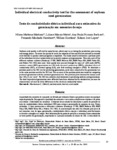Please use this identifier to cite or link to this item:
http://www.alice.cnptia.embrapa.br/alice/handle/doc/1026134| Title: | Individual electrical conductivity test for the assessment of soybean seed germination. |
| Authors: | MATTIONI, N. M.  MERTZ, L. M.   BARBIERI, A. P. P.   HAESBAERT, F. M.   GIORDANI, W.   LOPES, S. J.   |
| Affiliation: | NILSON MATHEUS MATTIONI, UFSM; LILIANE MARCIA MERTZ HENNING, CNPSO; ANA PAULA PICCININ BARBIERI, EMATER-RS/ASCAR; FERNANDO MACHADO HAESBAERT, UFSM; WILLIAN GIORDANI, UDESC; SIDINEI JOSÉ LOPES, UFSM. |
| Date Issued: | 2015 |
| Citation: | Semina, Ciências Agrárias, Londrina, v. 36, n. 1, p. 31-38, jan./fev. 2015. |
| Description: | ABSTRACT: Soybean seed quality is affected by many factors, which may occur during the production, processing, and storage phases. To ensure the quality of seeds, the adoption of fast and efficient methods to estimate seed viability in quality control programs is important. This study aimed to determine a partition point of the individual electrical conductivity test to predict soybean seed germination. Three lots each of five different soybean cultivars (Fundacep 57 RR, BMX Potência RR, BMX Força RR, BMX Turbo RR, and Nidera 7321 RG) were used. Seed quality was assessed through the mass of 1,000 seeds (MTS), moisture content (MC), germination test (G), bulk electrical conductivity (BEC), individual electrical conductivity (IEC), accelerated ageing (AA), and field seedling emergence (FSE). To determine a partition point in the IEC test for predicting germination, seeds were subjected to the germination test in the same position used for the IEC test. The accuracy of the partition point was tested by comparing predicted germination with the standard germination test. The partition point obtained for normal seeds was 130 ?S .cm-1.seed-1. The IEC test, however, had limitations in predicting soybean seed germination. The data for predicted germination were different from those obtained by the standard test, because the characteristics of each lot led to differences in the electrical conductivity values. RESUMO: A qualidade das sementes de soja pode ser afetada por inúmeros fatores que podem ocorrer em qualquer etapa da produção. Para garantir a qualidade das sementes é necessária a adoção testes rápidos e eficientes em estimar a viabilidade das sementes. O objetivo desse estudo foi determinar o ponto de partição do teste de condutividade elétrica individual (CEI) para estimar a germinação de sementes de soja. Foram utilizados 15 lotes pertencentes a diferentes cultivares (Fundacep 57 RR, BMX Potência RR, BMX Força RR, BMX Turbo RR, e Nidera 7321 RG). A caracterização dos lotes foi efetuada pelo peso de mil sementes, teor de água, germinação, condutividade elétrica massal e individual, envelhecimento acelerado e emergência a campo. Para determinação do ponto de partição as sementes foram submetidas ao teste padrão de germinação, respeitando-se a posição utilizada na leitura da CEI. A veracidade do ponto de partição foi testada através de comparação entre a germinação estimada e a obtida no teste padrão. O ponto de partição da CEI é 130 ?S .cm-1.semente-1. Entretanto o método mostrou limitação em estimar a germinação de sementes de soja. Características de cada lote influenciaram na CEI levando a diferenças entre a germinação estimada e o teste padrão. |
| Thesagro: | Soja Condutividade elétrica |
| NAL Thesaurus: | Soybeans Seed quality |
| DOI: | 10.5433/1679-0359.2015v36n1p31 |
| Type of Material: | Artigo de periódico |
| Access: | openAccess |
| Appears in Collections: | Artigo em periódico indexado (CNPSO)  |
Files in This Item:
| File | Description | Size | Format | |
|---|---|---|---|---|
| individualelectrical...2015.pdf | 232,19 kB | Adobe PDF |  View/Open |









